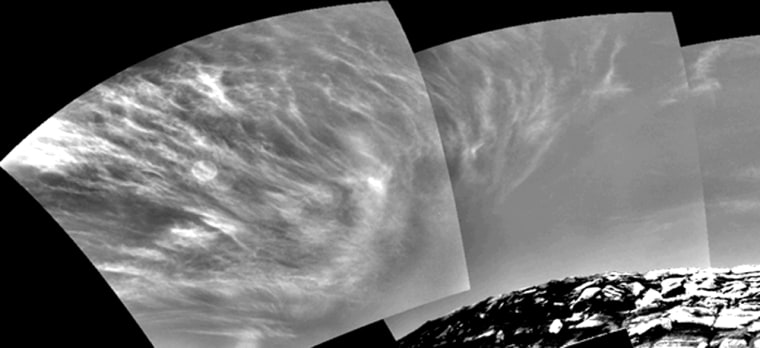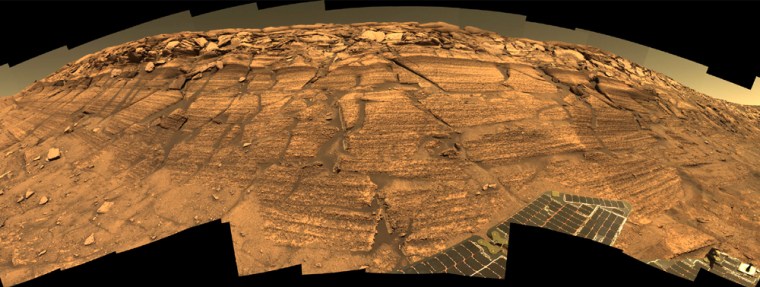NASA's Mars rovers have returned new evidence for past water, pictures of Earthlike clouds seen for the first time from the planet's surface, and a rock that doesn't look like anything scientists have ever seen.
Meanwhile, officials say both robots are in surprisingly good health and could continue their science investigations for months more, despite nagging health problems.
The Spirit rover, ambling through the Columbia Hills at the fringe of Gusev Crater, has uncovered a riot of rock forms and chemistries, including a mineral called goethite, which had not been found on Mars before. Goethite is common on Earth and forms only in the presence of water, though the water can be liquid, frozen or vaporous, said Goestar Klingelhoefer of the Johannes Gutenberg University in Germany.
Rover scientists presented their latest findings here Monday at a meeting of the American Geophysical Union.
'Diversity of rocks'
A chunk of terrestrial goethite about the size of a can of tomato soup, passed around during a press conference, was black and shiny and weighed about as much as a can and a half of tomato soup.
Other findings suggest the rocks of Columbia Hills have a history that included either a meteorite impact or volcanic activity, and that water was involved at some point.
Cornell astronomer Steven Squyres, principal investigator for the rover science instruments, said that just this weekend the team spotted a type of rock never seen before. Scientists haven't yet analyzed it, and Squyres wouldn't speculate on what it was. But he noted that the exposed rocks of the Columbia Hills, thought to be billions of years old, reveal an extremely complex structure and range of mineral types.
"We're stunned by the diversity of rocks," Squyres said. "This stuff looks like it was put into a blender."
Squyres said it is clear the rocks in the hills have been altered by water, but it's not yet known if it was liquid water. Several chemical signatures suggest liquid water, he said.
Partly cloudy skies
On the other side of Mars, the Opportunity rover emerged from the Endurance crater on Sunday after six months inside. "We're out," Squyres announced. The rover backed out of the crater, because it climbs better while going backward, he explained.
Opportunity, back on the Meridiani Planum, took pictures of wispy clouds that look strikingly like cirrus clouds on Earth.

"This is just a totally spectacular image," said NASA rover scientist Michael Wolff as he presented the first image. And upon unveiling the second: "I can't get enough of these."
Wolff said the clouds are almost surely made of water ice. They've been spotted by orbiting spacecraft before and are known to occur near the equator — where the rovers are — only when Mars is at aphelion, or at its farthest point from the sun on its elliptical orbit. During aphelion, about 40 percent less sunlight warms the planet, changing the climate.
The clouds are being blown by wind. Wolff estimates they're moving at up to 22 mph (10 meters per second).
Near full capacity
Opportunity's solar-powered batteries are working at near full capacity. The system produced about 950 watt-hours upon landing at the beginning of this year. Dust and a low, wintertime sun dropped that figure significantly at times in recent weeks. But lately it's been generating 900 watt-hours when the solar panel is pointed northward, said rover project manager James Erickson.
Spirit is producing just 400 watt-hours, but Erickson expects that to improve as spring brings the sun higher into the sky. For now, Spirit can only investigate rocks where rover drivers can keep its solar panel tilted north.
Erickson said the rovers are likely to continue exploring until some mechanical failure takes them down, rather than any problem with solar power generation. Spirit is still dogged by a balky front wheel, and Opportunity continues to struggle with a shoulder problem. Both have outlasted their 90-day warranties, however, and will have been on Mars for a year in January.
"It looks like they'll both be around for the anniversary next month," Erickson said.
Asked if they robots will still be at work in May, Squyres alluded to his hard-working team, which for much of the early part of the mission worked on Mars time, by joking that "the rovers have a better chance of being alive then than we do."
